After a positive 2018 World Cup campaign in which England reached the semi-final before then going on to lose in the final of Euro 2020, there is an ever-high expectation for the English side to put together an equally impressive run at the World Cup 2022 in Qatar.
They started the new calendar year 2022 with a 2-1 win over Switzerland and a 3-0 win over Ivory Coast in international friendly matches. Since then, England have put together some poor performances. They only achieved three draws against Italy (0-0) and Germany (1-1 and 3-3) besides three defeats against Hungary (1-0 and 0-4) and Italy (1-0) in the UEFA Nations League. Therefore, they ranked in fourth place at the end of the competition; England scored 11 goals but also conceded 9 goals in their last 8 matches.
Nevertheless, there is a feeling amongst many that the current crop of players is nearing the talent pool that performed so underwhelmingly for Sven Goran-Eriksson and Fabio Capello. Whilst England don’t currently have a team filled with the likes of David Beckham, Steven Gerrard, Frank Lampard etc., there is a young core to this side, who could well become leading world-class players in the not-too-distant future.
As such, there is a positive atmosphere in England with regard to the national team. At the same time, the tactics and nominations of Gareth Southgate are heavily criticised. So, just as at the last world cup, there are lower levels of expectations — something which only seemed to benefit them in Russia.
This tactical analysis gives an in-depth insight into the players likely to feature in this winter’s tournament, as well as giving an analysis of Southgate’s overall tactics and how the manager is likely to use said players.
Predicted starting XI
England’s squad is filled to the brim with young talent. You could theoretically have a host of players in the starting XI yet to enter their peak years. We can see these talents in the image below. Declan Rice, Mason Mount, Fikayo Tomori, Phil Foden and Jude Bellingham could all arguably put a case forward for a starting role in Southgate’s preferred side.
On the other end of the spectrum, Kyle Walker, Kieran Trippier and Jordan Henderson make up the only likely squad options who are perhaps beyond their peak years. Whilst Henderson might struggle for fitness, which would be a devastating blow for England, and Trippier faces steep competition from Trent Alexander-Arnold, Walker is playing still good football under Pep Guardiola at Manchester City.
And then we come to players in the peak years of their careers, as highlighted by the lighter pink section in the following image. There are certainly some key players in this stage of their respective careers. Centre-backs Harry Maguire, John Stones, Eric Dier and Conor Coady fall into this category, as do potential starters Jack Grealish, Raheem Sterling, left-back duo Ben Chilwell and Luke Shaw. Finally, Captain and talisman Harry Kane also falls into this category.
Overall, the squad is certainly one of the younger squads of a leading world footballing nation, and even the players in the peak years of their careers still have plenty of football left in them.
What’s most exciting, however, is the young players, who are arguably already leading talents on the world stage. Saka, Foden, Rice, Mount and Bellingham undoubtedly fall into that category from their performances in the last seasons, whilst Alexander-Arnold has failed to meet the heights of the previous three seasons but is nevertheless an elite talent.

As for formation, there is still some debate as to how Southgate will choose to have his side set up, let alone what players he will choose in that system. It’s been widely documented that Southgate likes to play a back three.
Most recently, it appears Southgate is preferring a 3-4-2-1 formation. It seems highly likely that the midfield will involve Rice in the double-pivot with Jude Bellingham or Jordan Henderson. It’s likely that Henderson would warrant a start in the midfield given his experience and leadership qualities, on top of his consistently strong performances for England in recent years. However, there’s an argument to be made that Bellingham is England’s most natural number 8, and with Rice best as a 6, Bellingham would arguably give England their most balanced midfield. Additionally, due to current form, Jude Bellingham should be the option next to Rice.
Ahead of this midfield pivot, England will operate with a front three. The one certainty is Harry Kane starting as the centre-forward. Tammy Abraham deserves credit for excellent performances at AS Roma, and the poacher will undoubtedly offer a threat off of the bench.
On either side of Kane, Foden would appear to have played himself into the starting XI given his scintillating club form. As for the other position, it’s incredibly difficult to predict. Sterling has been a strong performer for England and is experienced at international level, but a dip in club form may cost him a starting place, whilst Saka is widely regarded as one of the Premier League’s best players of the current season. Rashford, on the other hand, has been increasingly important for Manchester United this season before suffering an injury in the middle of September.
At the back, Maguire, Tomori and Walker seem set to start as a back-three, with Trent Alexander-Arnold at right wing-back, because of the missing competition from injured Reece James. As for the left wing-back position, it’s a toss-up between Chilwell and Shaw, but expect the Manchester United man to nick it. The wing-back pairing, and even overall formation, may well change based on the opponent. Against an opponent sitting deep in a low block, we could well see Southgate opt for Alexander-Arnold or Trippier, and Chilwell, giving these wingbacks the license to pepper the box with crosses.
Finally, in goal, Nick Pope had the chance to prove himself in the last matches but couldn’t really convince. Aaron Ramsdale might be the number one option for Enlgand. His current form for Arsenal will also prove helpful for Southgate’s side, and this should see him keep his place at the expense of Nick Pope and Dean Henderson.
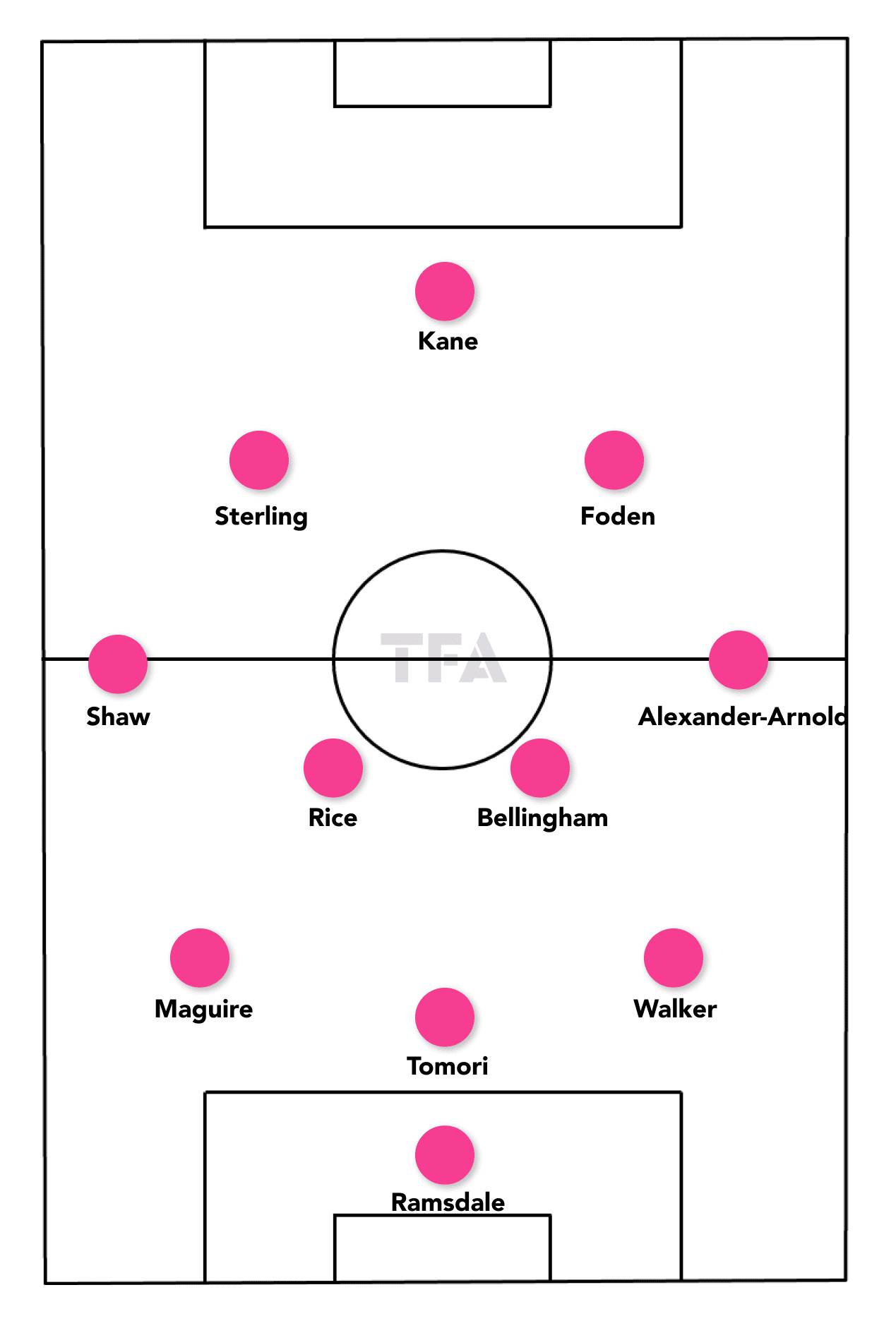
Attacking Phase
We can see that England are a patient possession side, playing with little directness, and therefore, unsurprisingly, with few final third passes per 100 passes. On top of this, Southgate’s side are far from partial to a long ball. Yet, despite this lack of directness, they are an incredibly efficient attacking side. We can see how highly they rank for goals per match, xG per match and touches in the penalty area per match.
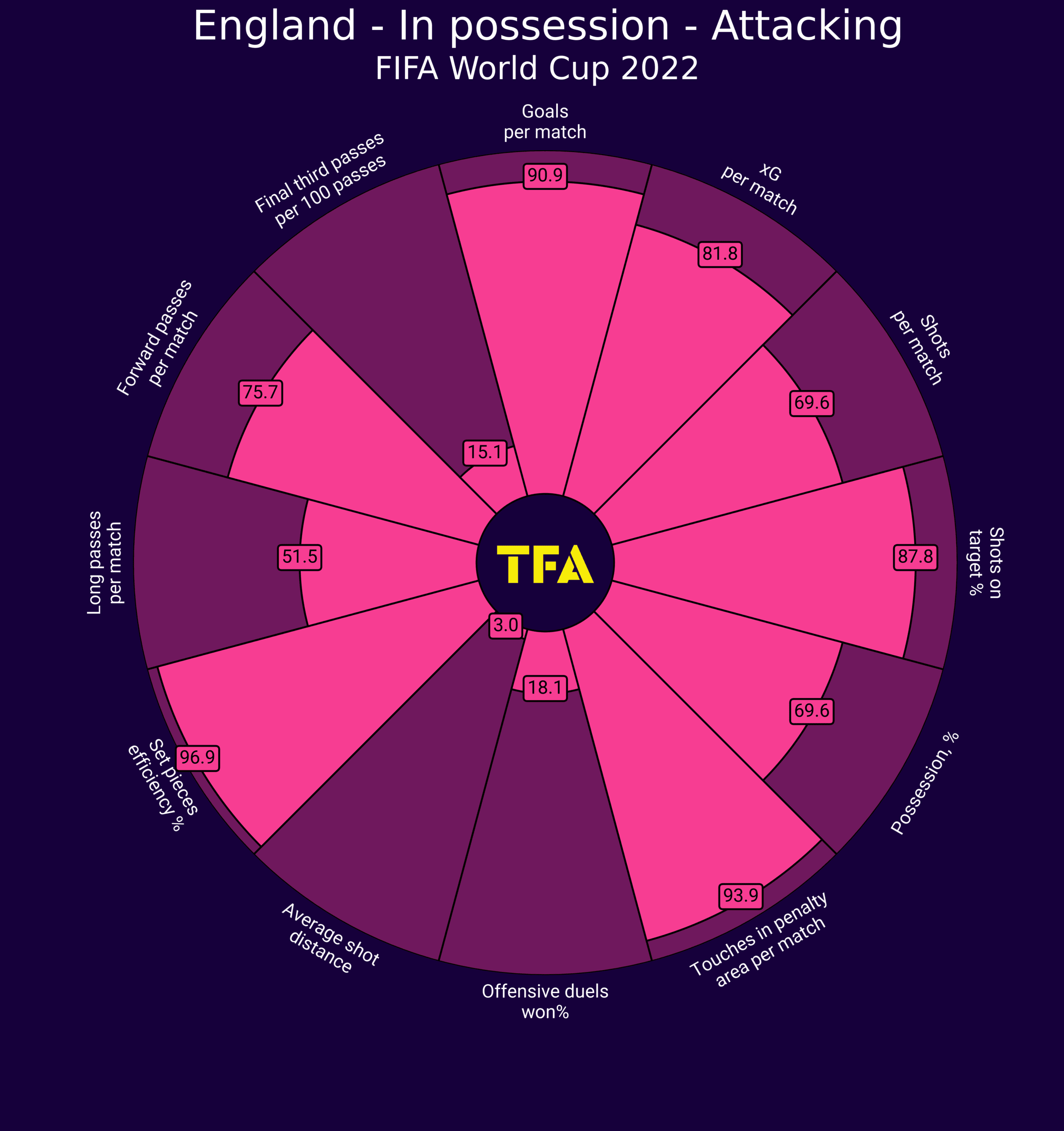
In terms of how they will set up in possession, we have to acknowledge that Southgate has flittered between using a back-three and back-four. However, with Declan Rice growing as a ball player and not just a defensive midfielder who can break up play, the West Ham midfielder provides Southgate with the flexibility to allow England to provide good build-up with both central midfielders.
From this shape, Rice will sit deep during build-up play, allowing the wingbacks to push on and giving England something very similar in possession with a back three to what they look like with a back four.
We can see this pattern in a game situation from the match against Germany, as we see Rice dropping between two centre-backs in order to allow the wing-backs to push forward, whilst also creating lots of central space.
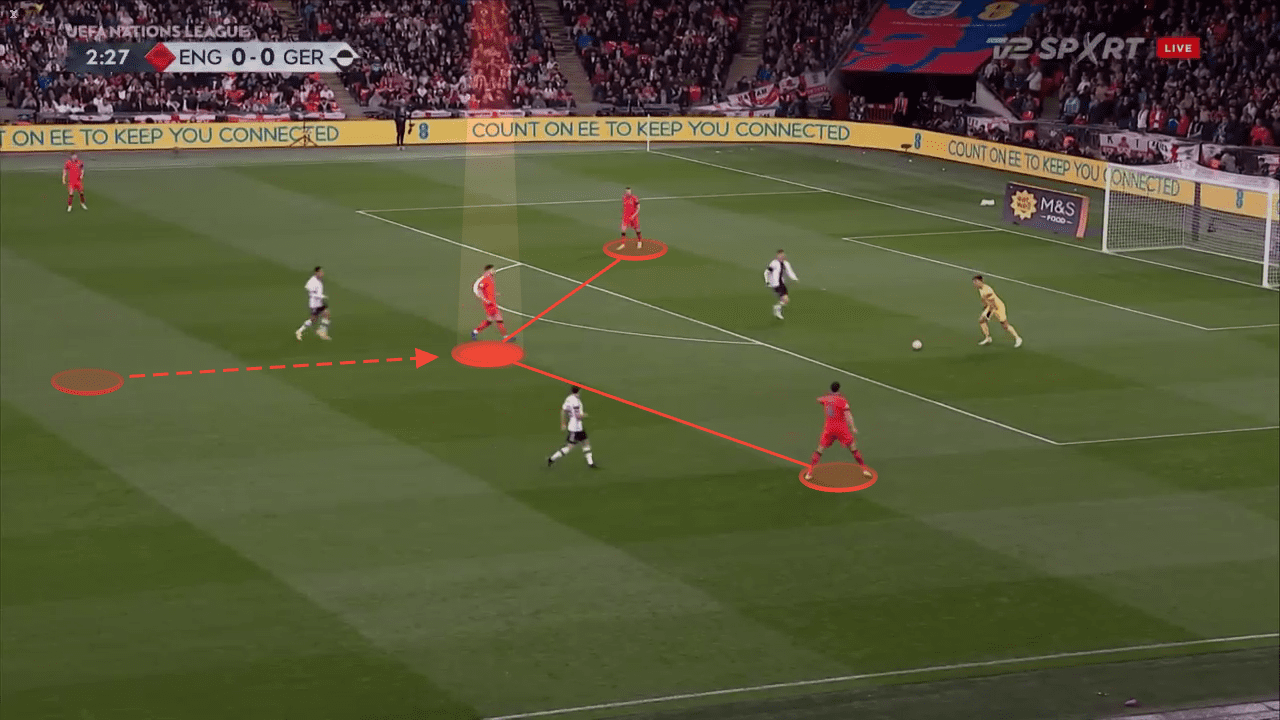
It’s well known that Kane likes to drop into midfield at any given time, and leaving two in the midfield during build-up provides more space for him to do this, along with creating plenty of different passing angles from the back three and wingbacks to find the mercurial front man.
Kane’s undeniable ability as a goalscoring threat ensures he is always marked closely by the opposition defence, and he is happy to be man-marked to create opportunities on either side of him for his attacking teammates.
In the following image, we can see how he remains central as England build up their game. He drops deep to collect the ball and switches the side of play.
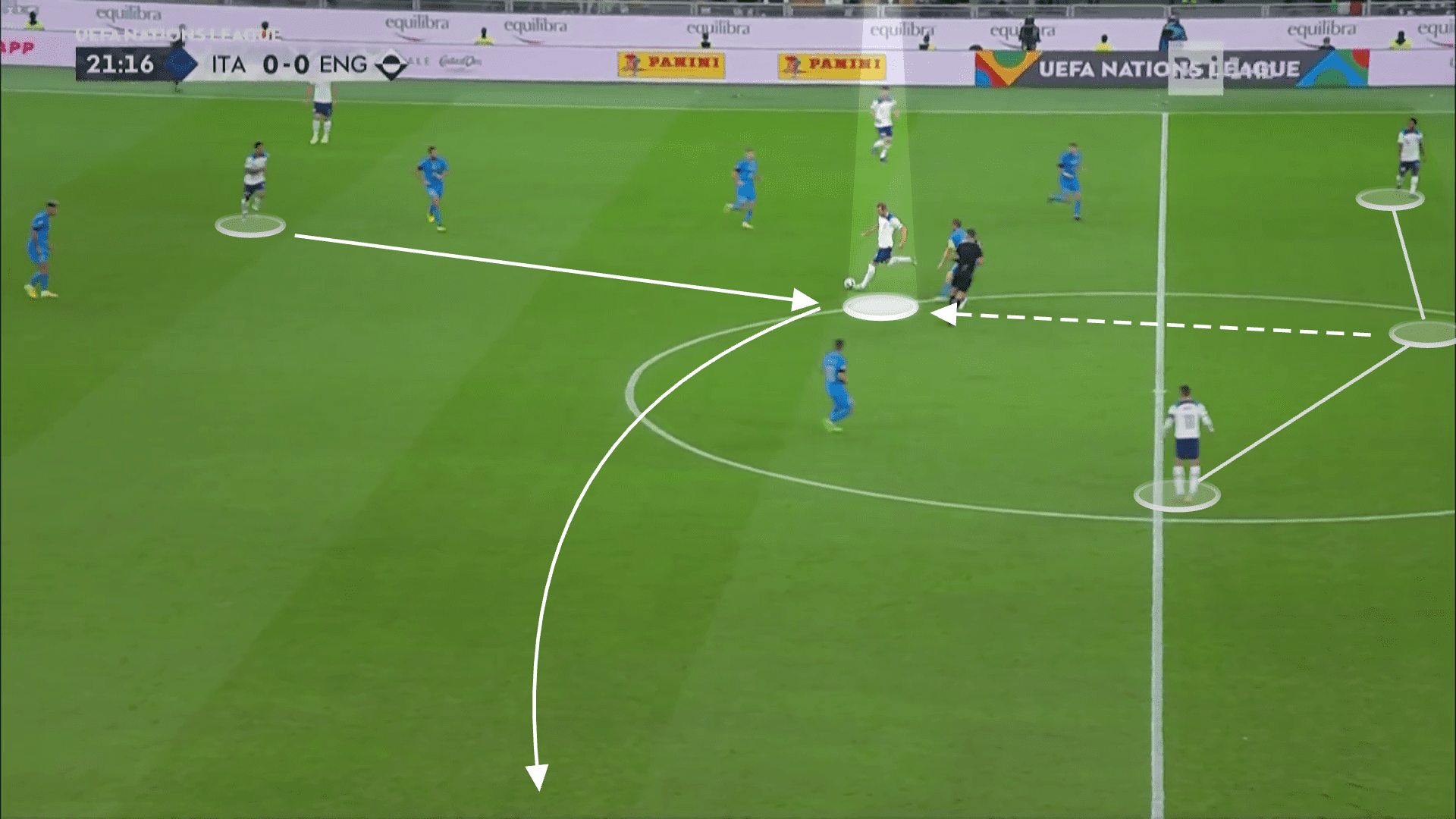
England will also use their attacking talent in wide areas to build play, and even when opponents don’t get pulled forward, their attacking wide players have the pace to latch onto through passes even with little space behind. We can see in the following image how Sterling is dropping deep and in a more central area as Shaw receives space on the left flank. Sterling passes the ball to Shaw, before then spinning in behind for the through pass.
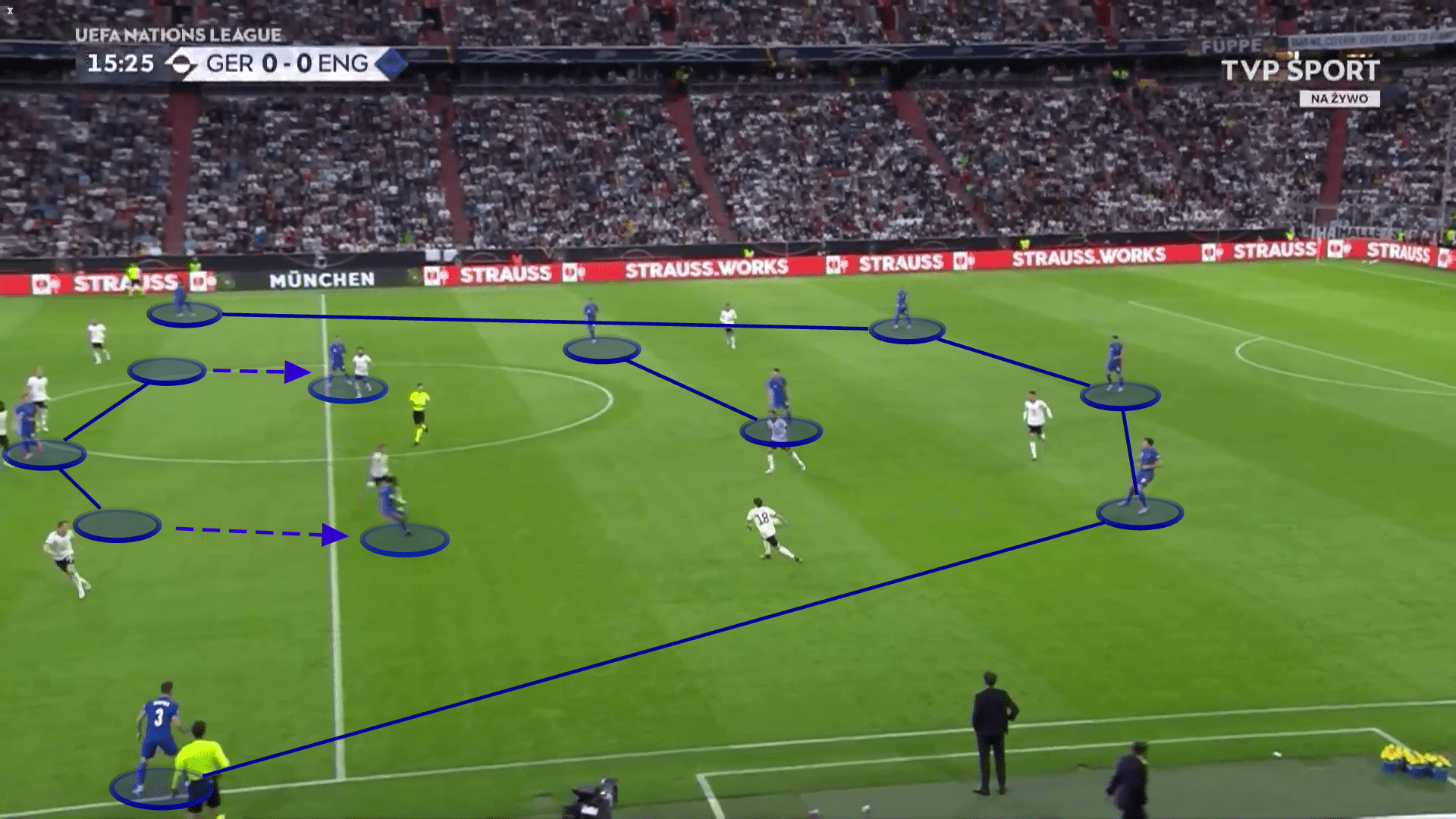
Defensive Phase
With England being a side that dominates possession so heavily, they naturally spend less time out of possession than other teams will. With this style of play, England will most commonly face sides looking to beat them with quick, direct counter-attacks.
Cutting these attacks out at the source is vital, and we can see that England’s ability to make recoveries in the final third is strong, suggesting they press well, and regain possession when the opponent has the ball inside their own third. In terms of just general solidity in defence, it’s encouraging for England fans to see their aerial duel win percentage and defensive duel win percentage, rank so highly too.
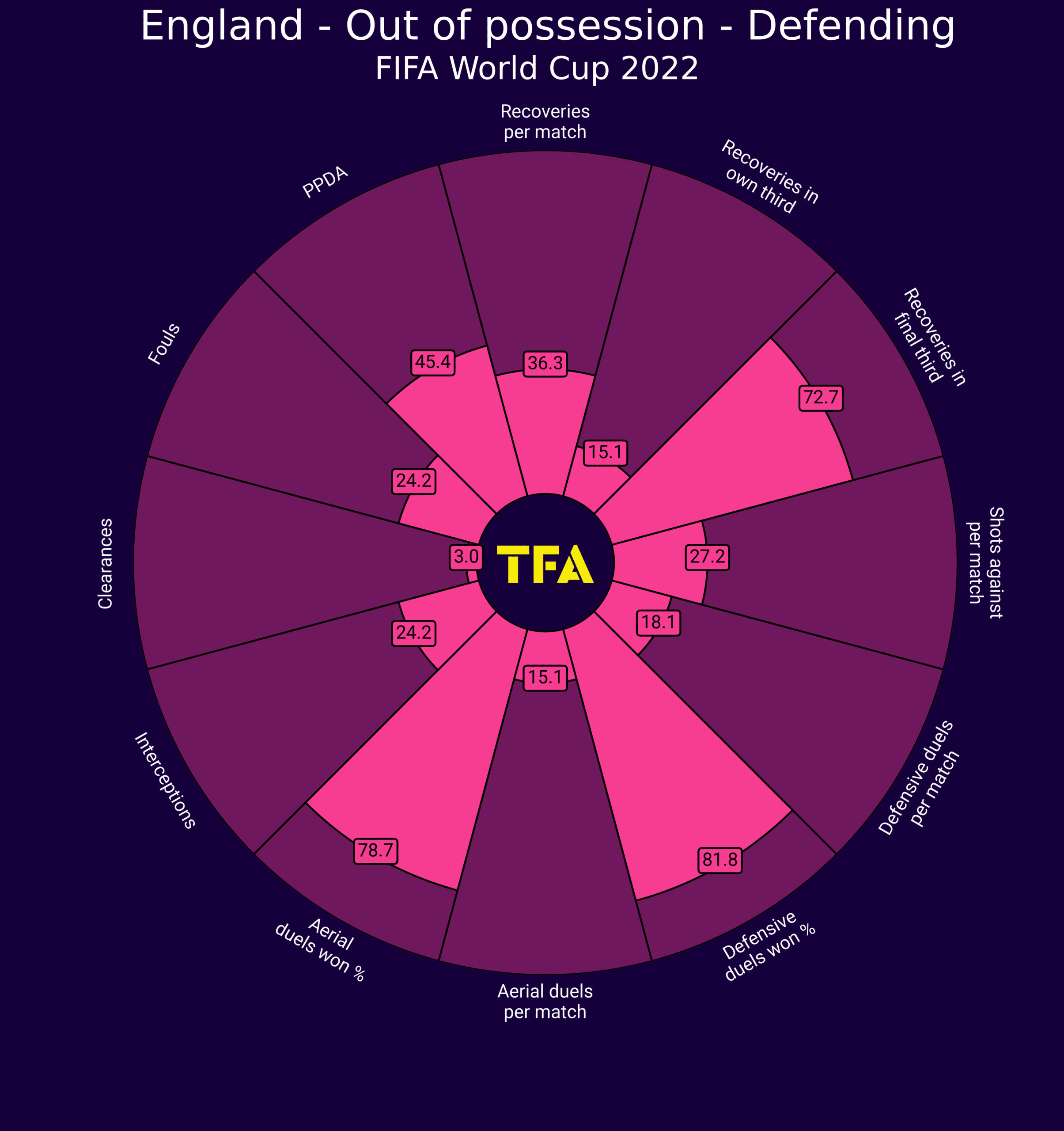
Look for England’s midfield to get particularly compact in an effort to protect the centre of the pitch. With a double pivot, they will remain compact, whilst still providing pressure when the ball is in the half-space. We can also see how one winger tucks inside, with the other winger and centre-forward preventing any easy passage out of pressure for the opposition side.
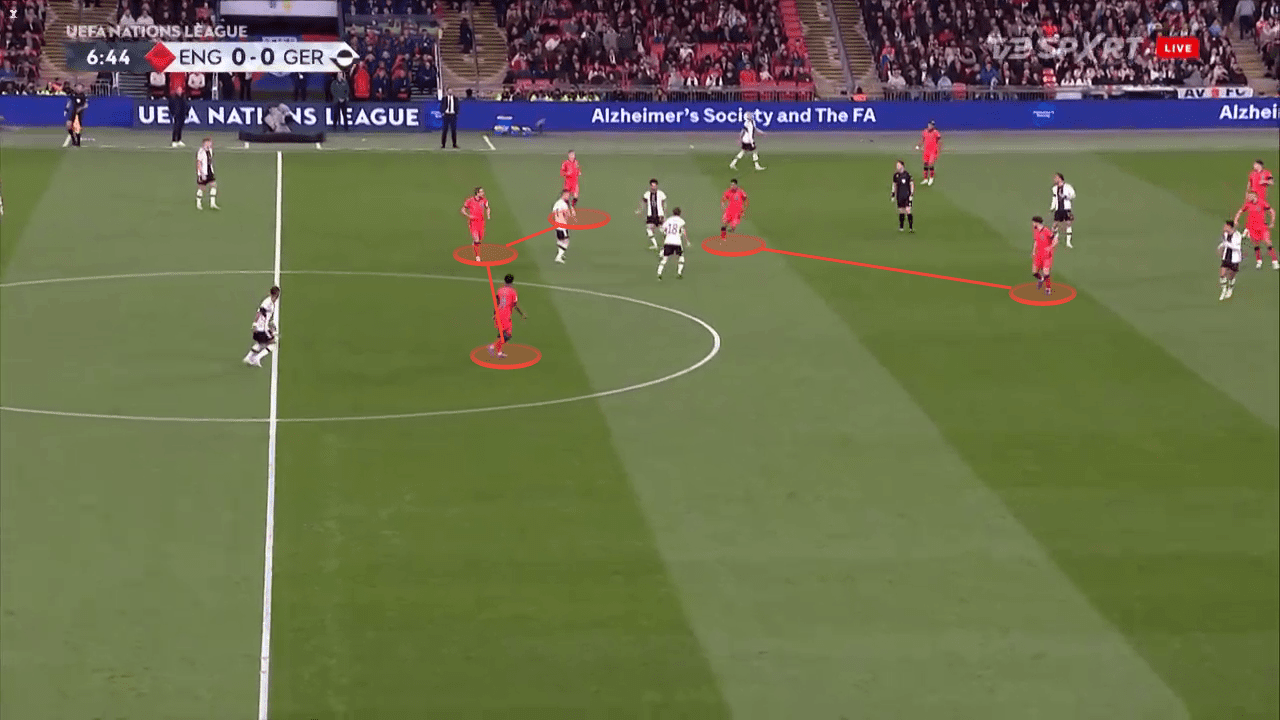
This compactness remains in the press as well. England will keep their front three narrow, pressing the ball and showing the opponent wide. They are supported by the central midfielders pushing forward to ensure that if the front three are beaten, there won’t be any space in the centre of the pitch for them.
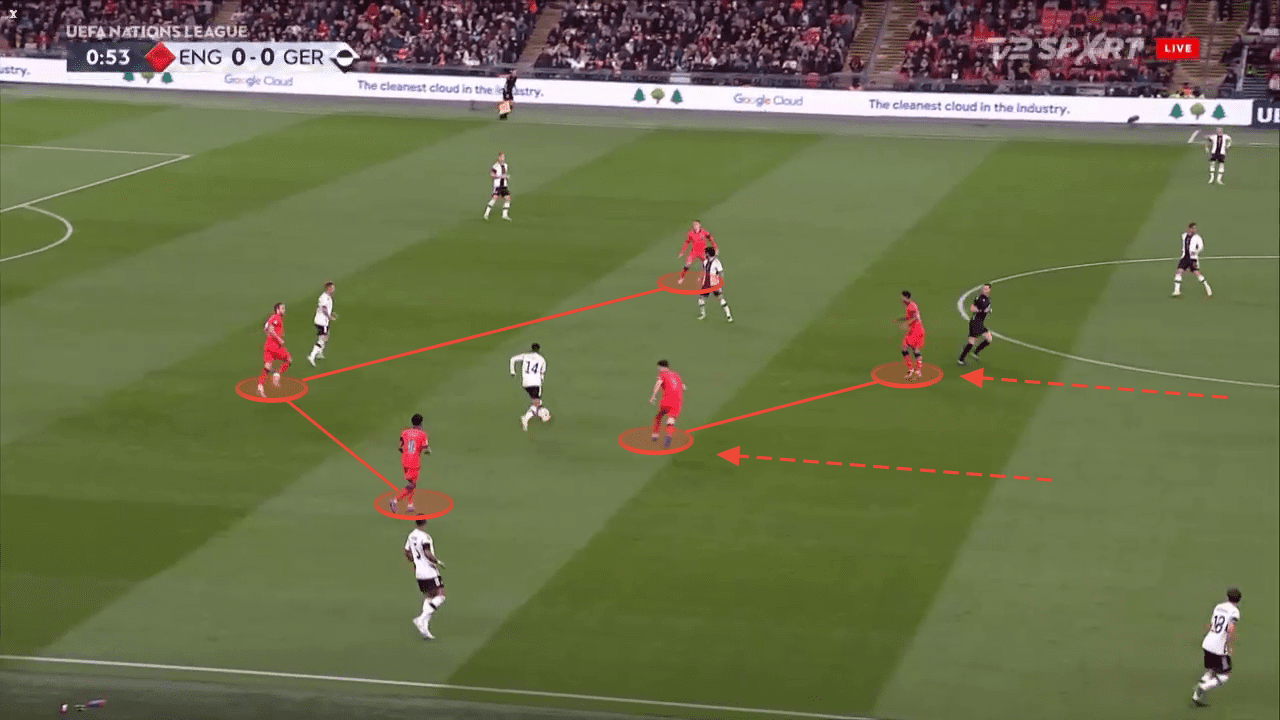
Rice’s ability to cover ground well and break up play so effectively gives England’s midfield and front three more freedom to press aggressively. Should they be beaten, as they are in the next image, Rice steps forward from his deep position to intercept the ball.
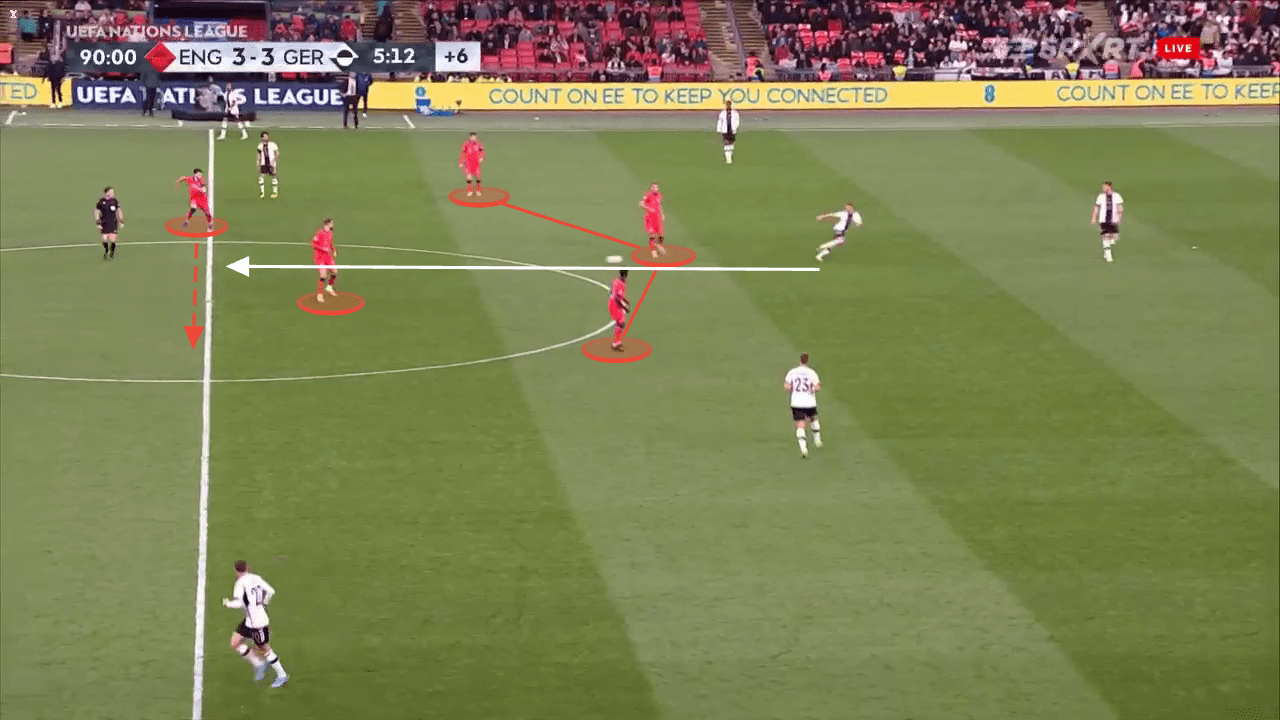
Transitions
When we talk about transition, we naturally look at what teams do as they transition from defence into attack, and then vice versa from attack into defence.
Starting with transition to attack, England will often look to keep possession and begin their patient build-up phase from the back. However, Kane can perform as a target man in transition, and England will also look to hit him in transition. With the pace of England’s wide players a constant threat, the likes of Foden, Sterling etc., will look to run past Kane and latch onto the knockdown, before continuing the fast break.
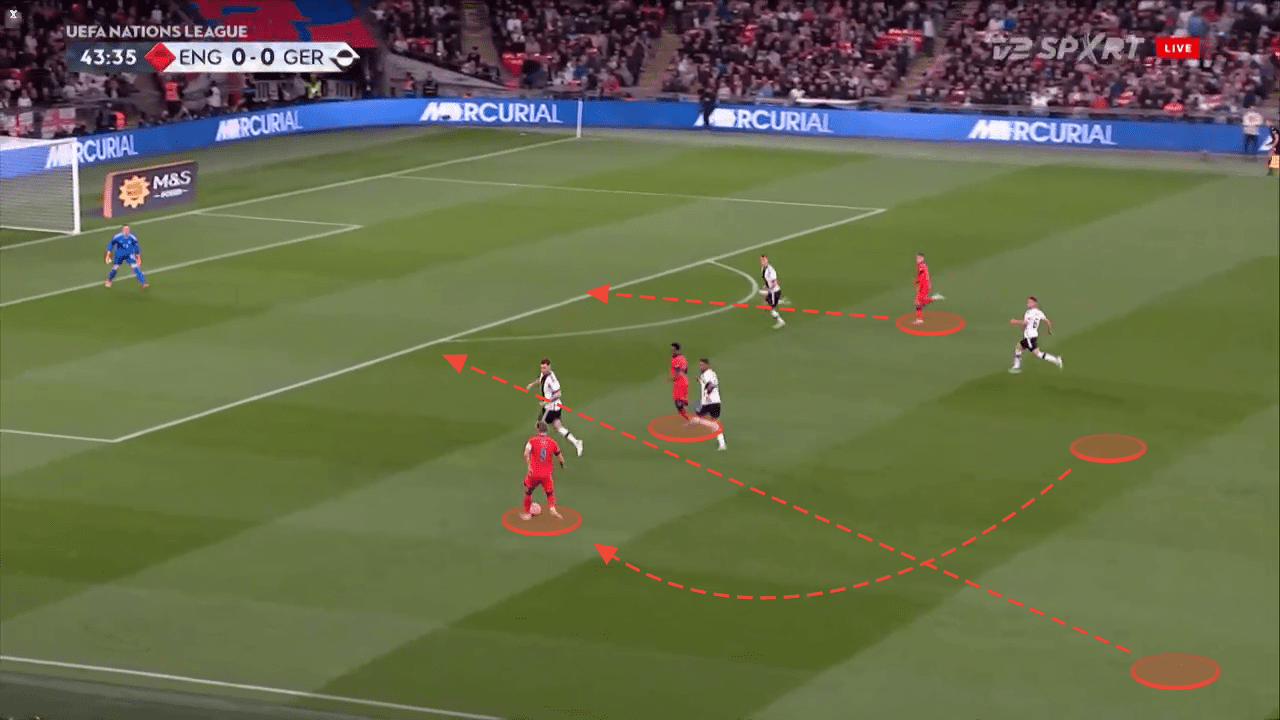
As for transition to defence, England counter-press well, using two basic structures to facilitate this. Firstly, if the ball is lost over a short distance, it will be immediately pressed by the player who gave up possession. This immediate pressure forces the opponent to move the ball quickly, perhaps before their teammates have transitioned into space to receive the ball and play out. As such, this can force a quick turnover, or at least encourage the opponent to merely clear their lines with a long ball forward.
However, England also structure their counter-press during the possession phase. In advanced attacks, Southgate’s side will have plenty of passing options in close proximity to the ball. This allows them to combine in tight spaces and advance possession, but it also allows them to quickly swarm the ball upon losing it, and quickly overload the opposition.
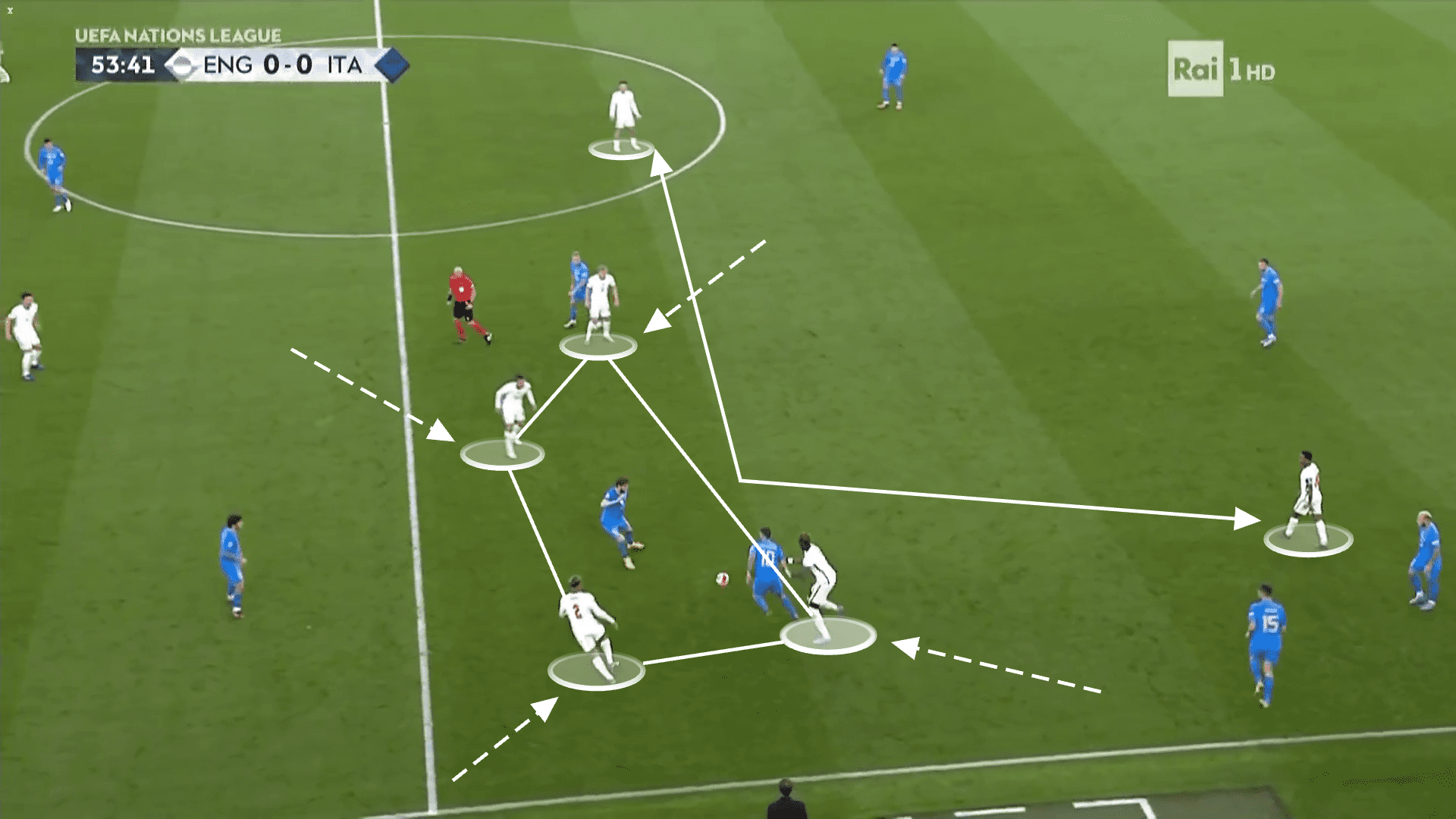
Attackers
As a group, England have a set of forwards that are taking a respectable amount of shots per 90, on top of taking a good amount of touches in the box per 90. There isn’t particularly any weak player. The wide players generally lean towards more touches in the box per 90 than their centre-forwards, and then adversely, the centre-forwards take more shots than the wide players. That’s to be expected.
In terms of wide players, Grealish and Sterling are clear outliers for touches in the box per 90. Kane, unsurprisingly, is high on shots per 90. Interestingly with Kane, he ranks relatively low on touches in the box per 90 despite this, giving an insight into how quickly he gets his shots away, but also showing that he will take plenty of shots from outside of the area too.
Moving on to look at actual goal contributions as well as xG contributions, we can again say that Kane ranks highly, whilst Abraham has outperformed his xG contributions.
Regardless, what we can ascertain from this is that England are blessed with a high-performing group of attacking players, and there will be top-level players not selected. It’s a good headache for Southgate to have, at least.
Midfielders
Then we move onto looking at England’s midfielders. Henderson is an outlier when measuring progressive passes and passes into the final third.
Foden ranks well in goal contributions, although is more likely to play out wide and then turning in into more of a 10 role. Mount and Bellingham are other stand outs.
Defenders
Whilst Southgate is spoilt for choice when choosing his best options in midfield and attack, England’s defensive options are slightly shallower. Whilst Chilwell and Shaw are two leading left-backs and the centre-backs are full of seasoned top-class players, there are only a few options for the right side.
Key Player
Kane is one of the best centre-forwards in the world and will be looking to perform as well as he did in the Euro last year. His game has moved on from just being an elite goalscorer, and Kane has become an outstanding provider, on top of his continued goalscoring exploits. We can see this by seeing how highly he ranks for not only attacking and shooting statistics but also passing and progressions statistics.
Firstly, in attack, he is in the upper echelons of the league for non-penalty goals per 90, xG per 90, headed goals per 90, and shots per 90. His lower ranking for xG per shot comes from his willingness to take on shots from longer distances. Also, his lower ranking for successful dribbles and touches in the box per 90 are likely down to his preference for quickly taking on shots.
He isn’t a dribbler by trade, and is far better playing quickly, whether that’s taking a shot, or moving the ball on with a pass.
As for his passing statistics, it makes sense to see him rank so highly for smart passes per 90, as well as passes to the final third per 90. Kane is an outstanding passer of the ball, and as he likes to drop into deeper areas to receive possession, he will often look for that long diagonal switch of play, which he does very effectively. Therefore we see his average pass length rank so highly amongst his peers in the league.
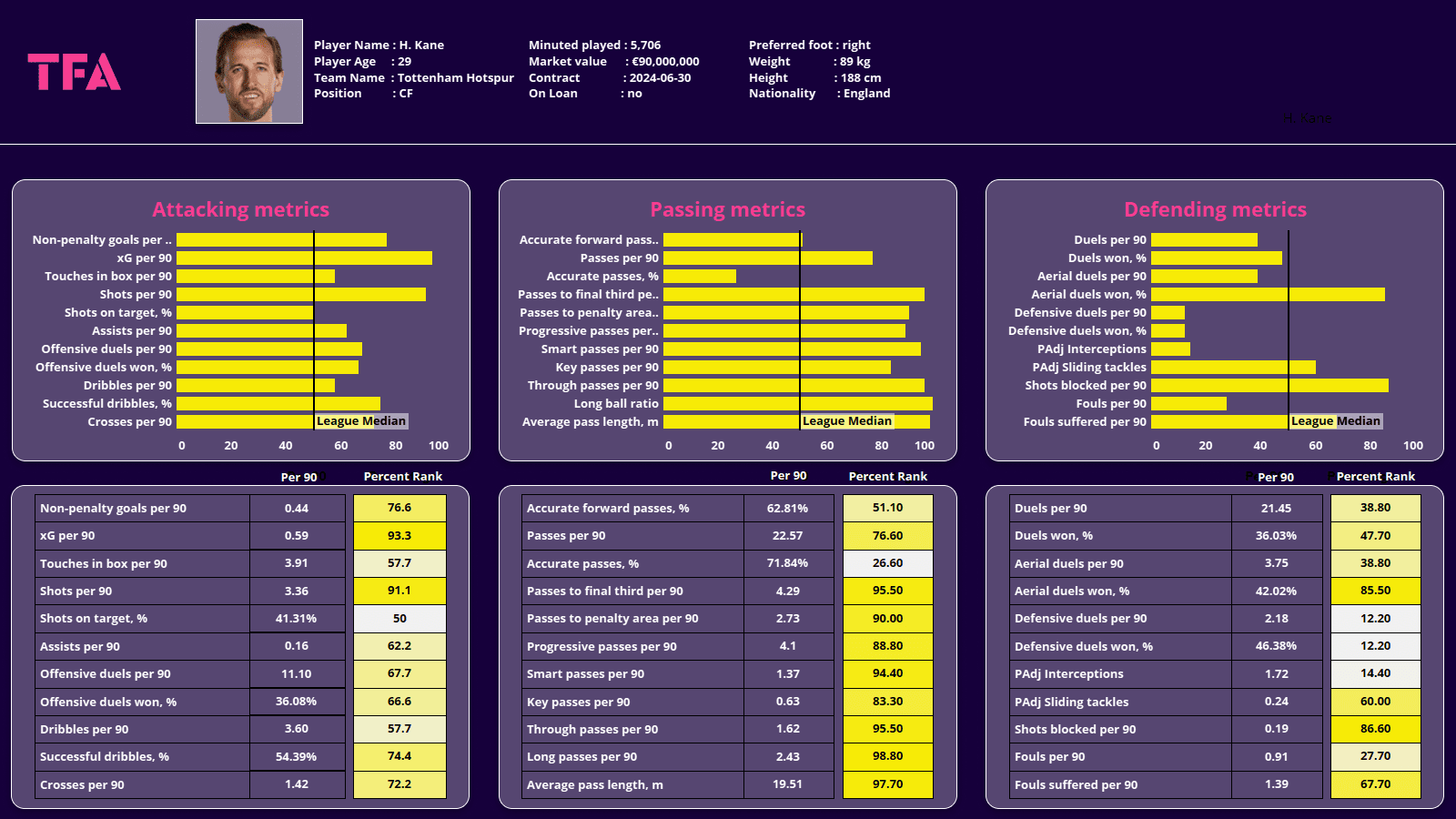
It will be interesting to see whether the transfer furore surrounding England’s captain will derail his tournament. He will be out to prove those doubters wrong once again, particularly those who haven’t taken his last World Cup golden boot seriously down to the penalties that helped him to secure that honour.
Tournament prediction
Despite poor performances in their last matches in the UEFA Nations League, England certainly are one of the big favourites to win this year’s world cup. Together with France and Brazil, the Euro 2020 finalists will be an interesting team to watch out for.
There is plenty of criticism of Southgate in terms of player nomination and playing style. The defensive philosophy could see them behind other well-rounded nations. But the individual quality of seasoned and talented players is outstanding. So in the knock-out phase, there is always the opportunity to beat opponents that might seem better.
Anything less than a semi-final appearance would be seen as a disappointment, but anything more than that would also be seen as an over-achievement. Southgate is honestly still riding the wave of goodwill that the World Cup performance from three years ago and the Euro performance brought. There will be more scrutiny this time around.

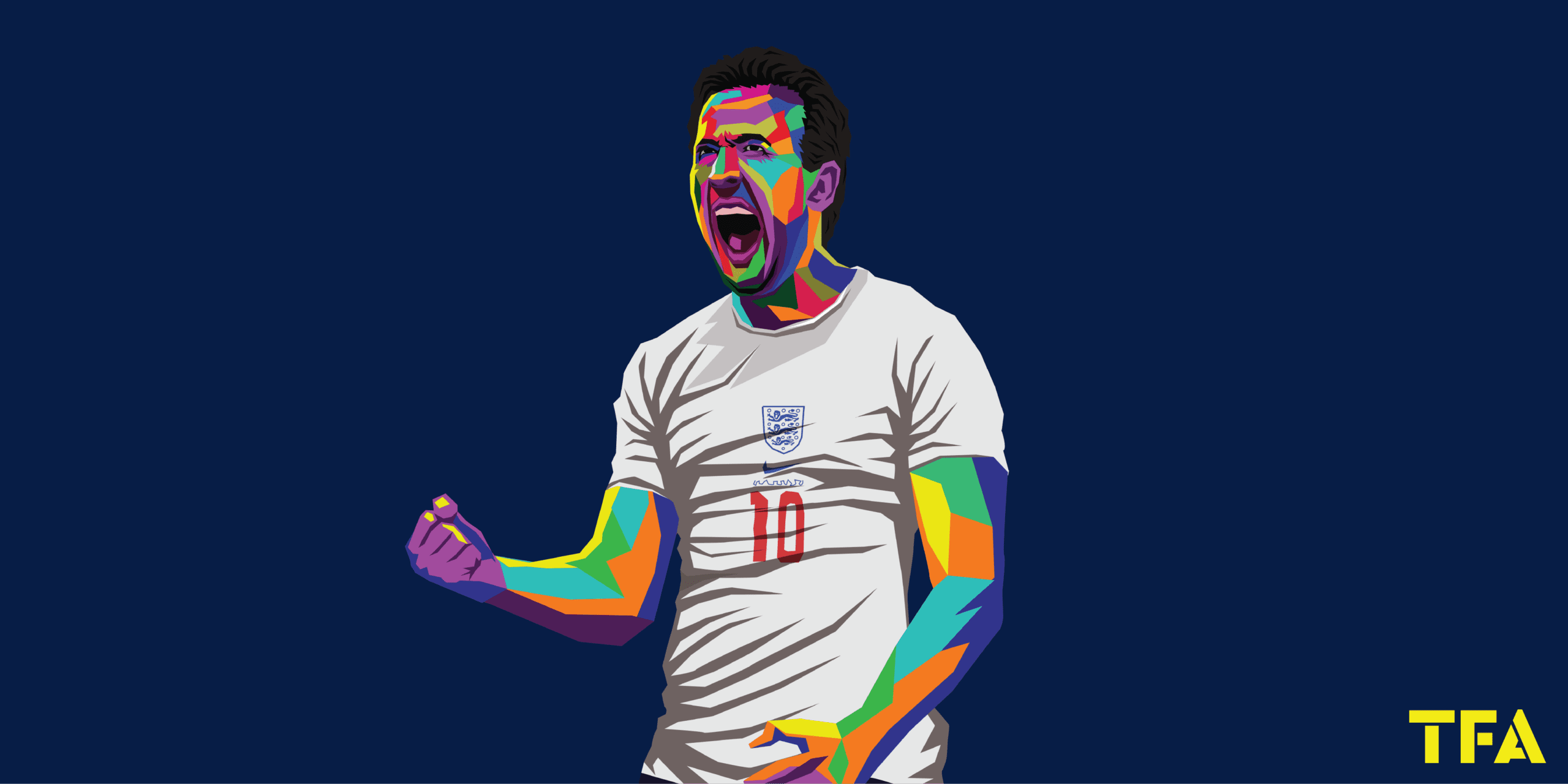



Comments